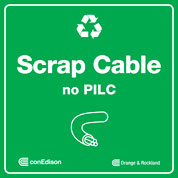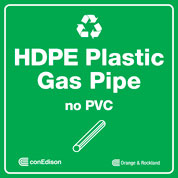Resource Efficiency
Conservation is a priority at Con Edison, and the wise and effective use of natural resources is one of our five key EH&S objectives. In 2012 Con Edison continued its use of an internal tool for facility managers, and all interested employees, to view and track company-wide and facility-specific data for waste generation and recycling, water consumption, and energy use. The ability to compare trends in annual performance between facilities, or view meter-specific interval readings, and track waste disposal records has increased visibility of these important metrics, and is the first step in driving improvements. As a benchmarking tool, this interface can be used to track the effectiveness of initiatives designed to reduce water and energy consumption at company buildings, and examine the material disposal efficiency of Con Edison’s office and field operations.
Reduce Cable Waste
Recovered Waste Materials
By extending the usefulness of the material it discards, Con Edison’s resource recovery program lightens the burden on the waste stream and generates revenue, which is good for the environment and for business.
Con Edison of New York minimizes waste and reinforces waste material separation and recycling efforts across the company. A recycling manual, posters located throughout company facilities, training modules, and an internal resource conservation website all include the various classes of waste found throughout company operations, and procedures for proper handling, collection, segregation, and disposal for each material type. Company facilities set aside areas that serve as recycling stations for a variety of waste streams. Clear signage helps sort refuse correctly for recycling.
49th Street Recycling
Material streams recycled by Con Edison of New York in 2012:
| Construction and demolition debris | 996 tons |
|---|---|
| Corrugated cardboard | 118 tons |
| Electronic equipment | 44 tons |
| Metal | 8,382 tons |
| Plastic | 60 tons |
| Mixed office paper | 348 tons |
| Sand/soil/dirt (clean construction fill) | 36,931 tons |
| Wood/pallets | 511 tons |
| Trash | 4,269 tons |
Orange and Rockland is committed to protecting the environment and conserving our natural resources. The company participates in and promotes programs that focus on resource conservation and waste minimization, and continues to explore alternative sustainable practices. These strategies are carried out company-wide.
Orange and Rockland’s recycling program continues a long-standing partnership that employs workers from Rockland ARC, a local organization providing support and services to those with intellectual and developmental disabilities. Supervised ARC workers help to break down retired Orange and Rockland equipment into component parts for re-sale.
The ARC workers assigned to Orange and Rockland separate waste paper, bale used cardboard and dismantle old cable, streetlights, reflectors, and meters. Those parts are then sold by Orange and Rocklandto recyclers. The program also provides a useful work experience for ARC of Rockland’s workforce.
Since the program’s inception in 1991, Orange and Rockland and its Rockland ARC partners have recycled more than three million pounds of paper, nearly a million pounds of cardboard, over a million pounds of steel and aluminum wire, and a half million pounds of assorted metals. Orange and Rockland estimates that this program has saved over a million cubic feet in landfill space.
Among the materials recycled by Orange and Rockland in 2012:
| Mercury street lamps | 4 tons |
|---|---|
| Fluorescent lamps | < 1 ton |
| Lead/acid batteries | 3 tons |
| Lighting ballasts | < 1 ton |
| Used oil | 65 tons |
| Plastic, glass, aluminum | 3 tons |
| Paper | 63 tons |
| Cardboard | 29 tons |
| Scrap cable | 79 tons |
| Scrap aluminum | 30 tons |
| Processed metal | 100 tons |
Electric and Gas Use
In 2012, Con Edison of New York used 97,422 MWhrs of electricity and 154,020 DTHs of gas for the purposes of powering, lighting, heating and cooling company facilities. These use totals represent decreases of 6.3 percent and 7.0 percent, respectively, from 2011 totals of 103,945 MWhrs and 165,638 DTHs.
Water Consumption
In 2012, we consumed over 3 billion gallons of DEP water, 120 million of which was used for basic water and sewage services at our facilities, with the rest used to generate steam for heating and cooling customers throughout the city.





 We recycled 90 percent of our nonhazardous waste in 2012.
We recycled 90 percent of our nonhazardous waste in 2012.
